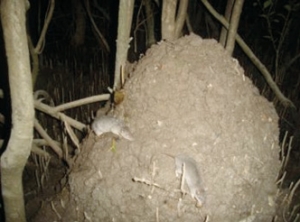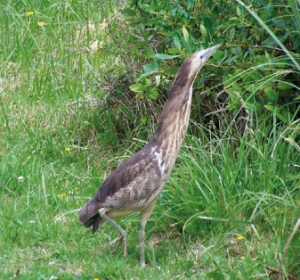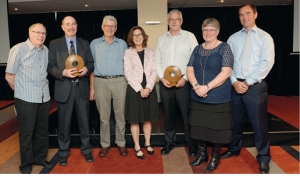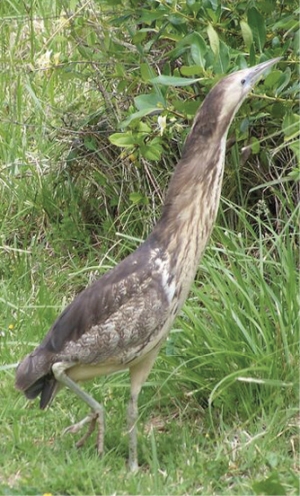Displaying items by tag: Conservation
The secret life of male bitterns
Finally revealed by DU transmitters
Did You Know
Did You Know?
Joining the dots on Watermouse
With support of several organisations, Janina Kaluza has been surveying, monitoring and researching the water mouse in a number of locations throughout the Wide Bay and South East Queensland region since February 2012. This work has expanded and built on previous research in the past 15 to 20 years by scientists within State Government and the broader community. However, gaps remain on information that Janina aims to fill.
The water mouse inhabits coastal areas of central and south east Queensland, Northern Territory and New Guinea, and is typically found in coastal saltmarsh and mangrove areas. A key sign of their presence is their nesting mounds that range from free-standing mounds in saltwater couch grasslands to sheltered mounds in sites such as the base of old grey mangrove trees (Avicennia marina) located within the intertidal zone. The water mouse forages in the mangroves at night, feasting on invertebrates such as crabs, shellfish and snails. Loss, fragmentation and degradation of their habitats are key threats to their survival.
Working with local councils, WetlandCare Australia has been awarded funding to undertake a number of small local projects to survey potential water mice habitat areas. The combined information from these projects will contribute towards completing the jigsaw puzzle on water mice in south east Queensland.
Another project focuses on surveying key habitat areas on Russell Island, one of the Southern Moreton Bay Islands, with funding support from a Redland City Council’s Conservation Grant. The water mouse was recorded on the island in the 1990s. The project aims to determine if the water mouse is still present and identify current threats to its habitat and survival. Surveys undertaken over three days in May this year and the data and survey results are currently being collated.
Funding through the City of Gold Coast’s Community Grants Program, WetlandCare Australia will be focussing water mouse survey effort in the Jacobs Well area in early 2016. Survey work will build on knowledge obtained in the 1990s that recorded the presence of the water mouse in this area. Logan City Council, through their Enviro Grants allows for surveying potential habitat areas on the Logan River in search of the water mouse. Approximately 40ha of mangrove areas will be surveyed in early 2016 to record the presence or absence of nests.
Water mice surveys will also be undertaken in early 2016 over 80ha of mangrove vegetation near the mouth of the Caboolture River with funding through the Moreton Bay Regional Council’s Community Grants Program. This project aims to identify the presence or absence of the water mouse in this area. The water mouse has been recorded previously at nearby Donnybrook.
Australasian bittern/matuku
Bitterns are found throughout New Zealand - in the North Island they predominantly inhabit Northland, Waikato and East Coast wetlands; while in the South Island they mostly inhabit West Coast, Canterbury and Southland wetlands. The most important bittern site nationally is Whangamarino Wetland, a large and diverse wetland complex in the Waikato.
Bitterns are large, stocky birds, with streaky dark brown and beige plumage on their throat, breast, abdomen and thighs; and dark brown on the neck and back. The head is dark except for pale beige around the cheek, forming a pale eyebrow. Plumage can vary significantly and may be age related.
Bitterns are rarely sighted due to their exceptionally cryptic behaviour, inconspicuous plumage resulting in excellent camouflage and the inaccessibility of many wetlands. They are mostly active at dawn, dusk and throughout the night. Bitterns are occasionally spotted in the open along wetland edges, drains, flooded farmland and roadsides.
They are very sensitive to disturbance and will silently creep away to avoid detection, or adopt the infamous ‘freeze’ stance (with the bill pointing skyward) if approached. This allows bitterns to blend into many environments, whilst maintaining a close watch of surroundings. If an observer continues to advance on a bittern, then it will eventually take flight in a laborious manner.
Often the only sign of bittern presence in a wetland is the male’s distinctive booming call at the beginning of the breeding season. Each call sequence may consist of 1-10 individual booms, with an average of 3 booms. Boom sequences are repeated at regular intervals, and normally preceded with inhalations or gasps. Females are mostly silent, apart from producing an occasional ‘bubbling’ sound upon return to the nest, or a nasal ‘kau’ when alarmed. Bitterns in flight may produce a resonant ‘kau’ or ‘kau kau’.
The breeding season is extremely long, spread over a 10-month period. Females construct a reed platform nest amongst dense vegetation deep within wetlands.
A clutch of 3-6 eggs is produced between August and December (peaking in November), and then incubated solely by the female for 25 days. Chicks remain in the nest for 7 weeks and fledge from November to May. Bitterns are considered an indicator of wetland health, as they are dependent on the presence of high quality and ecologically diverse habitats, which are rich in food supplies (such as eels, fish, freshwater crayfish, aquatic insects, molluscs, worms, spiders, frogs and lizards).
Bittern numbers have declined drastically since the arrival of European settlers, with over 90 percent of freshwater wetlands now drained and cleared. Ongoing wetland degradation continues to be the chief threat, resulting in habitat modification and loss, reduced food availability and poor water quality. Other threats contributing to bittern declines include predation by introduced mammals (particularly cats, rats, dogs and mustelids), human disturbance of nesting bitterns, as well as power-line and vehicle collisions.
You can help bitterns by becoming involved in wetland conservation and reporting all sightings (or calls) to your local Department of Conservation office. Most importantly you can protect wetlands on your property by planting native vegitation to create riparian buffers and fencing waterways from livestock.
Sabrina Luecht
Wildlife Project Administrator
(supplied by The Isaac Conservation and Wildlife Trust)
Special treatment for Egmont National Park
Project Taranaki Mounga, a ten year $24 million project involving pest eradication and reintroduction of species over the 34,000ha of Egmont National Park was last December given the green light with a funding commitment by the NEXT Foundation.
Local philanthropic organisation the NEXT Foundation announced it would invest up to $15 million in the restoration of Taranaki’s native ecology. The Foundation has committed to funding Project Taranaki Mounga, a 10 year project involving pest eradication and reintroduction of species in Egmont National Park.
The venture between the NEXT, DOC, iwi, and the Taranaki community will begin with pest and weed control and the ecological restoration of Egmont National Park and a small number of volcanic peaks and offshore islands. NEXT and DOC have committed to funding the first phase of 18 months with strong interest from other parties. DOC has committed just over $1.6 million for the first phase.
Work will start on phase one this February and during the 18 months the project intends to:
- complete a goat eradication feasibility plan;
- develop a translocation strategy for black petrel; pateke, kaka, kakariki, takahe, kokako and short tailed bats;
- develop a pest reinvasion monitoring regime;
- extend the predator trapping network to protect birds particularly whio and kiwi.
- translocate North Island robin into the park.
DOC Director General Lou Sanson said he was thrilled Project Taranaki Mounga has been given a green light with the commitment of funding from the NEXT Foundation.
“Project Taranaki Mounga has been recognised as one of the next big exciting and bold conservation ventures,” said Lou Sanson.
The project’s vision is to protect our mountain for our wellbeing – Ko Taranaki tooku whakaruruhau.
“Given the strong Iwi connection and Whakapapa to Taranaki Mounga, Iwi are a critical partner in the successful delivery of this project.
Lou said the project will create a legacy of cultural, environmental and economic benefits for generations to come.
“Healthy flourishing ecosystems will sustain the quality and abundance of freshwater underpinning the Taranaki economy which adds to New Zealand’s image, and showcases this country’s leadership in pest eradication.
“It’s exciting knowing lessons learnt in Taranaki will be able to be transferred to even larger landscapes when successful,” said Lou.
Brown teal/Pateke
The Isaac Conservation and Wildlife Trust
Brown teal/Pateke
The Isaac Conservation and Wildlife Trust’s seven brown teal/pateke breeding pairs laid their first clutches, with 34 ducklings hatched in total.
Laying of second clutches has now begun. Two older pairs have been released on Rotoroa Island in the Hauraki Gulf, making way for a clutch of orphans coming off Great Barrier Island – providing new genes for the captive breeding programme. The Trust continues to be the major breeder in producing the largest brown teal output for release into the wild.
Find out more about the Trust’s captive breeding activities on Facebook
Order of Merit for top bloke
Why has James (better known as Jim) Campbell been awarded the Member of New Zealand Order of Merit? Usually it is for achievement or service to the community and for Jim Campbell mainly for services to conservation.
But there is more – read on.
The Order is awarded to those “who in any field of endeavour have rendered meritorious service to the Crown and the nation or who have become distinguished by their eminence, talents, contributions, or other merits”. That is our DUNZ Patron, our Jim.
The list of reasons below makes that clear:
- A sensitive farmer
- A compulsive tree planter
- A digger of large holes
- A breeder of birds
- An arch-enemy of vermin
- A National Trust Covenanter
- Patron of Ducks Unlimited New Zealand
- A teller of tall (and short) stories
- An outstanding host
- A generous, encouraging and humble gentleman.
There are few people of the Wairarapa who haven’t heard of Jim Campbell – and many well beyond. His reputation as a farmer, conservationist, wetlands creator, water fowl breeder and welcoming host, precedes him. At age 73, an age at which for many, signal retirement, Jim Campbell is constantly in motion – helping, giving, inspiring, leading and directing in the cause of environmental quality.
If ever an Honour was richly deserved; this is it – long overdue to an outstanding environmental role model.
Alan Fielding
River Story Award and Morgan Foundation
In conjunction with Kaiwaiwai Dairies Ltd, Ducks Unlimited NZ won joint first place in the River Story Award at a recent Morgan Foundation Dinner.
Held at the Ridges Hotel in Wellington, the Award recognises conservation efforts to improve water quality before it enters lakes and waterways.
Kaiwaiwai Dairies received the award for the construction of a serpentine waterway on their farm to slow the passage of the water down, thereby allowing more time for nature to extract nutrients from the water.
DUNZ was recognised for the effort we have put into Wairio (Southern Wairarapa) for not only the creation of water fowl habitat but for also slowing down the water so when it enters Lake Wairarapa it has a greatly reduced nutrient loading.
Our thanks go to all the organisations that have contributed time and money over the last 10 years.
The family of Joanne and Gareth Morgan of Wellington established this charitable trust primarily for the purpose of reducing wealth disparities between people. In particular the focus of the Foundation is on improving the lives of the poorest folk in the world and enabling people to participate in their society and workplaces to the full extent of their potential. The Foundation work extends in New Zealand to public interest research and education as well as to investment in conservation and natural environmental enhancement.
The trustees are Joanne, Gareth and independent Charles Purcell. The advisory board for the trust comprises the Morgan’s four children – Ruby, Floyd, Jessi and Sam. The Manager of the Trust is Margaret Mather, whose responsibilities include liaising with applicants for funding, administering the grants programme, and ensuring the Foundation participates in philanthropic community activities to the extent the trustee’s desire. The trust has no religious orientation although willingly finances religious-based organisations doing work that satisfies their criteria.
Project Bittern (Matuku) Report
Ducks Unlimited NZ AGM (23 July 2016)
Emma Williams has continued working on the bittern project assisted by me and other volunteers.
Key points are:
- Emma graduated with her Doctorate Degree at Massey University which was based on bittern research. A huge thank you to DU for helping fund a major part of her work to learn more about this iconic critically threatened species.
- A total of 10 male bitterns (six 2014 and four 2015) were captured at Lake Whatuma and transmitters attached. Of these 10 birds, nine left the lake over summer with one bird remaining on the lake. The bird that remained on the lake was found dead in late April in raupo and cause of death unknown. Four of the birds have returned to the lake in July and one other is being monitored at a wetland 10kms away. In spite of extensive searching the location of the remaining four birds is unknown, but it is most likely they will return to the lake in time for spring like birds did last year. The DU funded transmitters have contributed significantly to our much increased knowledge of this secretive bird.
- Emma travelled to Christchurch earlier this year to place transmitters on two bittern chicks that had been found abandoned not far from Travis wetland on the outskirts of Christchurch. These have been monitored by local people. One bird is still alive near the mouth of the Waimakariri River north of Christchurch and the other was found dead in mid May near the mouth of the Opihi River over 100kms south of Christchurch. This bird was examined and appeared to have died of starvation which is not uncommon overseas with bittern. Very interesting results plotting the movement of this juvenile bird and proves that bittern can move considerable distances.
- We held a very successful meeting on April 6 for the local Waipukurau community, landowners and Iwi to up-date them on the bittern project. Over 50 people attended and DU received well deserved acknowledgment for their significant contribution to the project.
- Emma has done no further school talks in the Wairarapa but will complete others this spring organised jointly between her and Gill Lundie. She has spoken to a number of schools in Hawke’s Bay. Emma continues to provide written articles for Flight.
- Bittern are a species under severe threat from wetland loss, predation, poor food supply and human disturbance. Population trends are negative. The Department of Conservation operate a conservation threat classification system of bittern and last month bittern were upgraded to the highest level of Nationally Critical Threatened Species. Kakapo and takahe share the same ranking which highlights the plight of this iconic wetland bird.
- It is important that DU continue to support the bittern conservation programme and encourage others (DOC, Forest & Bird) to commit to the preparation of a national bittern recovery plan.
- In 2015 DU Directors agreed to support the bittern project to the level of $25,000 to enable Emma Williams to continue her research work and purchase transmitters. Expenditure to date is (Emma Williams $7322) and (transmitters $9211.25). The remaining $8467 will be utilised this coming spring/summer.
John Cheyne
Coordinator Project Bittern (Matuku)
Whio in the spotlight
With less than 3000 whio around New Zealand, they need all the help they can get.
A two-day Whio Recovery Workshop was held in June at Tokaanu, near Turangi, where people with a passion for the endangered nativeblue duck gathered to hear information, ask questions and get what answers they could, although the overwhelming conclusion was that there is still lots more to be done.
More than 50 people involved in whio protection in the North Island took part in the workshop, which was held at the Genesis Energy Tokaanu Power Station.
The attendees were able to grow and maintain links with like-minded people, share their skills, learn more about research and consider some of the innovations being tried to ensure the safety of whio and increase its numbers. That included new and better ways to keep predators away and, if possible, eliminate themwith best practice monitoring and trapping techniques.
The workshop group also visited the Turangi Trout Fishery, where they were shown how to set and use predator traps and how to set nets to catch ducks.
The recovery programme involves not only paid workers, but private organisations and volunteers. They give up their own time to set traps, walk trap lines every two to three weeks,and keep an eye on the ducks at the same time.
This workshop was not just a talkfest, but included the chance to learn about the latest research and tools, and take part in practical demonstrations such as trap maintenance and safety.
Threats to whio
Introduced predators are the whio’s worst enemies. A whio recovery plan includes trapping and the use of toxins to reduced predators. Without such work, there would be no whio.
Stoats are the main killers, along with ferrets, feral cats, falcons and dogs. But events such as floods, that scour out riverbanks, can take away the whio’s food source. Even resource consents, water use and discharge of dirty water are a threat. Then, for the females, their moulting phase makes them vunerable to predators, as they cannot fly away.
The recovery project, without which the whio would be gone, is expensive and a significant partner is a necessity. Genesis Energy has stepped in to provide funding - $2 million overfive years - and its staff have become involvedin helping with recovery projects.
In the early 1980s, the Moawhango Tunnel was commissioned in the upper Tongariro River and whio numbers decreased in that area because of the changed flow volumes of the river. By 2004, however, work was done to create a minimum flow and the population rebounded.
Predation remains the key risk
Around the country, both Government workers and volunteers continue to trap predators and take care of eggs. Floods can wipe out a whole season’s ducklings. There is also a need to increase gender diversity and the transfer of juveniles to other areas helps with this.
Recent use of DOC200 traps and double set traps (where two predators are caught in the same trap), along with aerial 1080 drops, have helped survival. David Rogerson reported setting 85 traps and catching 50 rats a fortnight along the Maramataha River in the King Country. Malcolm Swanney trained Fern, a German short-haired pointer dog, to become a champion whio finder who will never hurt a bird.
The Ruahine Ranges
Janet Wilson, a keen tramper from the Manawatu, started work as a DOC volunteer trapper in 2011 in the Ruahines.
The Ruahine Whio Protection Trust was formed as a collective and now a strong group of volunteers works along120 kilometres of the range. Many drive to Napier and work the Napier ridge to the Orva and back south. There are 1500 traps and it is steep terrain.
Wellington Tramping and Mountaineering Club volunteers drive to Hawke’s Bay once a month to check and manage traps from that side.
Janet said she was disappointed that not enough protection work was done by DOC. Along those ranges there were 60 huts, mostly old. There are 500 plus tracks, and lots of rivers. “We have seven groups working together as a collective and using DOC200 traps.”
Jessica Scrimgeour said Janet and the collective have worked hard to keep the system going. “Janet’s commitment has driven the plan over the years.”
Taranaki trial
A trial whio recovery plan was put in place during 1999-2000 in Taranaki to investigate a viable population. Fifteen birds were introduced, but, for a variety of reasons, did not survive. The group persevered with stoat control in 2002 and in 2008, they released 170 ducks, with a 50-50 gender balance.
Between 2011 and 2016, the number of pairs has been good with a survival rate of about 81 percent. The next phase is to increase gender diversity. Predator control remains essential, but it was also found that it is best to transfer juveniles and not adults to other areas.
Some New Zealand Deer Stalkers Association members have agreed to help out by checking traps while out hunting.
Tongariro
Rachel Abbot talked about the Kia Whariti biodiversity project, which also involves DOC and Genesis Energy, in the 20,000-hectare Tongariro forest, bordered by the Whakapapa, Whanganui and Mangatepopo rivers, where they are using DOC 200 traps plus double set traps, and aerial 1080 drops. Since 2007, trapping has been in progress with 700 traps along the trap line.
Future threats
Another possible threat to whio is plantation forestry logging. However, recent information suggests that forestry companies who are aware of the presence of ducks will move their operations away from any nesting sites until the chicks have left.
The Whio Workshop was a success, but there’s such a lot to do, so let’s hope it will lead to more protection for the lovely whio. Alison Beath, the convenor, a senior ranger with DOC, is to be congratulated on the event.






